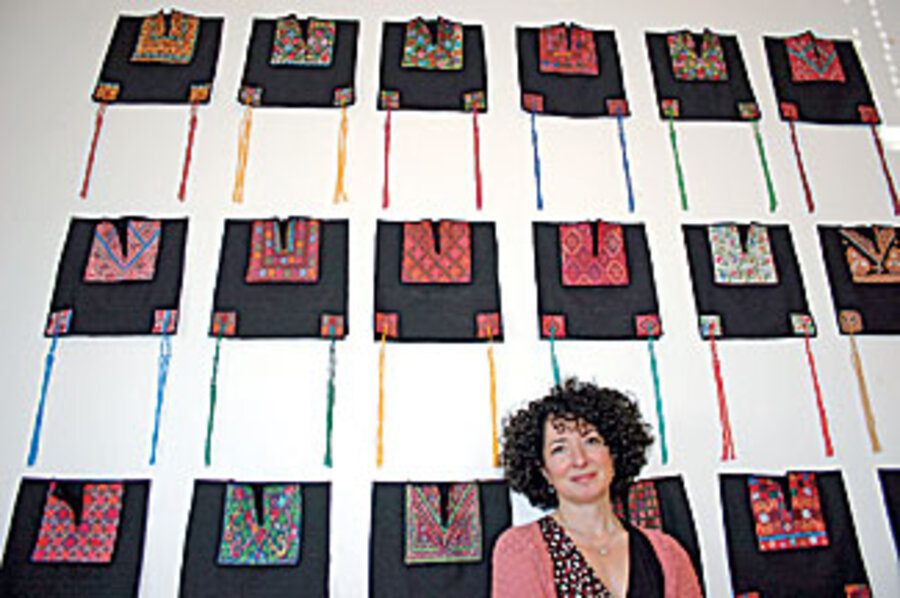People making a difference: Andi Arnovitz
Loading...
| Jerusalem
Since she was a little girl Kansas City, Andi Arnovitz has had a fascination with fabrics. Her father ran three fabric stores in Missouri, and she loved to touch the textiles, learning where they came from, and imagining what future stories they would weave.
So perhaps it isn't surprising that she grew up to be an artist who, after a decade of life in Israel, creates mixed-fabric works that turn heads and challenges assumptions.
The top part of each piece is unmistakably Palestinian, made of the central square in a traditional woman's embroidered dress. The bottom part is unambiguously Jewish, made to resemble the knotted strings that hang either from a prayer shawl or other religious men's garb. The end result: a colorful hybrid cloth, each piece mixing an Arabic qabbeh with Jewish tsitsit, fittingly named "Garments of Reconciliation."
"This is about putting oneself in the other person's clothing. And I think that's the only way we're going to get anywhere," Ms. Arnovitz explains in her sunny studio, where 30 child-sized garments hang on the wall waiting for an appropriate exhibition space. A life-size version of one is now on exhibit at the Stern Gallery at the Hebrew University of Jerusalem.
"I deliberately made them small because ... I think peace education starts early," says Arnovitz, who retains something of the friendly Midwestern girl with apple-red cheeks and a joyful mess of curly hair. "I tried to take two classic cultural garments of two peoples in conflict. It was a way of bringing together two traditions in a gentler way, with my own hands."
This fusion was sure to raise eyebrows, says one of the gallery owners who deals in Arnovitz's work. "The combination will be shocking to some people," says Karyn Gellman of State of the Arts in Jerusalem. "But it's that refreshing, contemporary take on things ancient that I find fascinating. Arnovitz has really carved a niche for herself in the integration of textiles, which is unique to her work. It's so modern, but it rests on ancient texts, and there's something very original about it."
It's not the first controversial piece she's produced – and probably not the last. One of her recent creations is a set of translucent clothes representing the sotah, or a woman accused of adultery in biblical times, on display at a feminist art gallery in Jerusalem.
Arnovitz and her husband, David, came to Israel in 1999, ostensibly for a two-year sabbatical. They soon found themselves at home and decided they wanted to stay for the long haul. The beauty of Jerusalem and the biblical vistas inspired her paintings, etchings, and collages. Her art took off. Patrons loved her print work which, in her words, often focuses on "romanticized" snapshots of life here, repeating motifs of cypress leaves, palm trees, walled Jerusalem, and its stone archways.
Around the same time, however, the Palestinian intifada, or uprising, hit, darkening the mood. She created a powerful three-dimensional piece called "Tehilim Belt," meant as a takeoff on a suicide belt – armed not with explosives but with little rolls of paper prayers of tehilim, the Hebrew word for Psalms.
"Essentially, it was flipping this destructive thing on its head and making it a prayer for peace," she says. "I'd have to be living in La-La Land not to be aware of the conflict and not to have it affect my work. As a mother of five kids, two of whom have already been through the Israeli army, and as someone who has close friends who are Palestinians, I am constantly wading through these relationships."
To feed both her art and her penchant for collecting, she developed friendships with dealers in textiles, jewelry, and other Middle Eastern handiwork. Along the way, she befriended a Palestinian bead dealer named Badawi. She and David would accept invitations to visit Badawi and his family in their village – a prospect that frightened some of their friends.
"The average Westerner doesn't understand Arab hospitality," she says. "They don't understand that when you're invited to someone's home, you're taken care of, and nothing is going to happen to you."
She enlisted the helping hands of others, too. She hired an teenage Israeli boy – a friend of one of her children – to tie knotted fringes similar to those on a Jewish prayer shawl. Ibrahim Abu Khalaf, a Palestinian fabric dealer, played a key role in helping to bring the garments to life. He helped her find the right kind of black Egyptian cotton and had some of the sewing done in the Palestinian town of Ramallah.
"I don't know what was going on in her mind when she decided to put the Palestinian embroidery with the Jewish tallit [prayer shawl], but I think she wasn't thinking politics," Mr. Abu Khalaf says. "She's a woman of peace, and sometimes she has a vision of something that she needs to share. I think if she were prime minister, we'd have peace tomorrow."
Arnovitz did not set out to be a peace activist, but says she can't help but let life amid the conflict influence her art, calling it representative of the paradox of living here, she says.
Since tsitsit fringes are used as part of men's prayer, she decided to have hers knotted differently than they would be when made for religious uses, and with a different number of strings. Then she dyed them in bright colors to match the Palestinian embroidery.
"I was concerned that some rabbinical authorities would come along and say I'm tampering with a holy garment," she says. "But I think quite the opposite. I'melevating it." r





